Saint symbolism
Christianity has used symbolism from its very beginnings.[1] Each saint has a story and a reason why he or she led an exemplary life. Symbols have been used to tell these stories throughout the history of the Church. A number of Christian saints are traditionally represented by a symbol or iconic motif associated with their life, termed an attribute or emblem, in order to identify them. The study of these forms part of iconography in art history. They were particularly used so that the illiterate could recognize a scene, and to give each of the Saints something of a personality in art. They are often carried in the hand by the Saint.
Attributes often vary with either time or geography, especially between Eastern Christianity and the West. Orthodox images more often contained inscriptions with the names of saints, so the Eastern repertoire of attributes is generally smaller than the Western. Many of the most prominent saints, like Saint Peter and Saint John the Evangelist can also be recognised by a distinctive facial type – as can Christ. In the case of later saints their actual historical appearance can also be used; Saint Bernardino of Siena (1380–1444) is one of the earliest whose distinctive appearance was well-known from early prints and is nearly always used by artists. Some attributes are general, such as the palm frond carried by martyrs.
The use of a symbol in a work of art depicting a Saint reminds people who is being shown and of their story. The following is a list of some of these attributes.

The symbols of the four Evangelists are here depicted in the
Book of Kells. The four winged creatures symbolize, clockwise from top left,
Matthew,
Mark,
John, and
Luke.

The
key as symbol of St. Peter
.jpg)
The
Synaxis of the Twelve Apostles. Russian, 14th century, Moscow Museum.
| Saint |
Symbol |
|---|
| Andrew |
saltire |
| Bartholomew the Apostle |
knife, human skin |
| James, son of Zebedee |
pilgrim's staff, scallop shell, key, sword, pilgrim's hat, astride a white charger, Cross of Saint James |
| James, son of Alphaeus / James the Just |
square rule, halberd, club, saw |
| John |
book, a serpent in a chalice, cauldron, eagle |
| Jude |
sword, square rule, club, ship |
| Judas Iscariot |
thirty pieces of silver |
| Matthew |
angel |
| Saint Matthias |
axe |
| Peter |
Keys of Heaven, boat, fish, rooster, pallium, papal vestments; man crucified head downwards on an inverted cross, vested as an Apostle, holding a book or scroll. Iconographically, he is depicted with a bushy white beard and white hair, and wearing a blue robe and yellow mantle. |
| Philip |
column; elderly bearded saint and open to God man, holding a basket of loaves and a Tau Cross |
| Simon |
boat; cross and saw; fish (or two fishes); lance; man being sawn in two longitudinally; oar |
| Thomas |
the twin, placing his finger in the side of Christ, axe, spear (means of martyrdom), square (his profession, a builder) |
Saints listed by name
A
| Saint |
Symbol |
|---|
| Acathius of Melitene | crown of thorns |
| Agatha of Sicily | tongs or shears, veil, bells, two breasts on a plate |
| Agnes | lamb |
| Alfege of Canterbury | axe |
| Alfred the Great | codex, crown, orb/scepter |
| Ambrose | bees, beehive, dove, ox, pen |
| Anne, grandmother of Jesus | door, book with the Virgin Mary reading, red robe and green mantle |
| Anthony the Great | monk's habit, bell, pig, T-shaped cross |
| Anthony of Padua | Child Jesus, bread, book, lily |
| Athanasius of Alexandria | bishop arguing with a pagan, bishop holding an open book, bishop standing over a defeated heretic |
| Augustine of Hippo | dove, child, shell, pen, book |
B
| Saint |
Symbol |
|---|
| Barbara | tower, chalice, ciborium, cannon |
| Barnabas | pilgrim's staff, olive branch |
| Benedict | broken cup, raven, bell, crosier, bush |
| Benno of Meissen | fish with keys in its mouth, book |
| Bernard of Clairvaux | pen, bees, instruments of the Passion |
| Bernardino of Siena | tablet or sun inscribed with IHS, three mitres |
| Blaise | wax, taper (candle), iron comb |
| Bonaventure | communion, ciborium, cardinal's hat |
| Boniface | oak, axe, book, fox, scourge, fountain, raven, sword |
| Bridget of Sweden | book, pilgrim's staff |
| Brigid of Kildare | cow, crosier, Brigid's cross |
C
| Saint |
Symbol |
|---|
| Casimir of Poland and Lithuania | royal attire of crown and red robe lined with ermine, lily, cross, rosary; sometimes two right hands |
| Catherine of Alexandria | wheel, crown, sword, book |
| Catherine of Ricci | ring, crown, crucifix |
| Catherine of Siena | stigmata, cross, ring, lily |
| Cecilia | organ |
| Cerbonius | geese |
| Charles Borromeo | cardinal's robes, communion |
| Christopher | giant crudely dressed, torrent, tree, branch or large staff, Carrying the Child Jesus on shoulder |
| Clare of Assisi | monstrance |
| Clare of Montefalco | cross |
| Clement | anchor, fish, Mariner's Cross |
| Corbinian | saddled bear |
| Saints Cosmas and Damian | a phial, box of ointment |
| Saints Crispin and Crispinian | shoes, millstones |
| Cyriacus | deacon's vestments |
D
E
| Saint |
Symbol |
|---|
| Earconwald | bishop travelling in a chariot |
| Edmund the Martyr | quiver of arrows |
| Edward the Confessor | king crowned with a nimbus and holding a sceptre |
| Saint Eligius | bishop portrayed with a crosier in his right hand, on the open palm of his left a miniature church of chased gold; with a hammer, anvil, and horseshoe; or with a horse |
| Elijah | cave |
| Elisabeth of Hungary | alms, flowers, bread, the poor, pitcher |
| Emilianus | monk on horseback |
| Elizabeth of Aragon | crown |
| Erasmus of Formiae | windlass |
| Eric of Sweden | king being martyred at mass |
| Eustace | hunting clothes, stag, bull, crucifix, horn, oven |
F
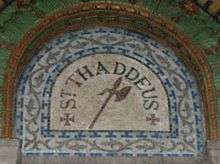
An axe, the symbol of the martyrdom of
Judas Thaddeus and other saints
G
| Saint |
Symbol |
|---|
| Gabriel | is archangel, trumpet, armour, wings, scroll stating “Ave Maria Gratia Plena” |
| Genesius | theatre mask |
| Genevieve | lit candle, bread, keys, herd, cattle |
| George | dragon, soldier or knight in armour, often on white horse, especially in the East, Cross of Saint George |
| Gertrude of Nivelles | crown, tapir, lily, mouse |
| Giles | Benedictine habit, hind |
| Gregory the Great | papal tiara, crosier, dove (often portrayed at his ear) |
H
I
| Saint |
Symbol |
|---|
| Ignatius of Antioch | a bishop surrounded by lions or in chains |
| Ignatius of Loyola | Eucharist, chasuble with Jesuit-style collar, book often inscribed with "Ad majorem dei gloriam", or the letters AMDG, the letters "ihs" with a cross across the h (traditionally with three nails below the letters, and the letters and nails surrounded by the sun's rays), sword, cross. |
| Imerius of Immertal | hermit's garb and bird of prey |
| Irene of Tomar | palm of martyrdom |
| Isidore of Seville | bees, pen, book |
| Ivo of Kermartin | depicted as a lawyer, holding a document, in legal dress. |
J
| Saint |
Symbol |
|---|
| Jerome | lion, cardinal clothing, cross, skull, books and writing material, stone in hand |
| Joan of Arc | shield, Cross of Lorraine |
| Saint Joanna | lamb |
| John Berchmans | Rule of Saint Ignatius, cross, rosary |
| John Chrysostom | bees, dove, pen |
| John of God | alms, heart, crown of thorns |
| John the Baptist | lamb, head on a platter, animal skin (the camel-skin coat of the Gospels), pointing at Christ or a lamb, often portrayed carrying a long crudely made cross |
| Joseph, spouse of Mary | Child Jesus, lily, rod, plane, carpentry square, purple robe and brown mantle |
| Juan Diego | tilmàtli |
| Justin Martyr | axe, sword |
| Justina of Padua | palm frond, knife, unicorn |
| Juthwara | round soft cheese |
K
L
| Saint |
Symbol |
|---|
| Lambert of Maastricht | palm of martyrdom |
| Lawrence of Rome | cross, Gospel Book, gridiron, palm frond, purse of money, attired as a deacon in a dalmatic, accompanied by a group of poor people. |
| Leander of Seville | pen |
| Leonard of Noblac | lock, chain, manacles or fetters |
| Liborius of Le Mans | pebbles, peacock |
| Louis IX of France | royal attire of crown and blue robe decorated with golden fleur-de-lis, crown of thorns, nails |
| Lucy | cord, eyes on a dish, lamp |
M
| Saint |
Symbol |
|---|
| Margaret of Scotland | reading |
| Margaret the Virgin | dragon in chains |
| Martha | aspergillum, dragon |
| Martin of Tours | goose; sharing cloak with beggar |
| Martin de Porres | broom, a cat, dog and a mouse eating from the same plate |
| Mary Magdalene | jar of ointment, red egg |
| Matilda | purse, alms |
| Maurice | soldier in armour, banner with red cross |
| Maurus | scales, spade, crutch |
| Menas of Crete | two camels |
| Michael | scales, banner, sword, dragon |
| Monica | girdle, tears |
| Mungo | fish with ring in its mouth, bell, tree, bird |
N
O
| Saint |
Symbol |
|---|
| Oda of Scotland | depicted wearing a long blue gown with one shoulder bare; usually carries a staff or a book; always shown with a magpie on her hand and a crown under her feet |
| Olaf of Norway | axe in Norway's coat of arms |
P
| Saint |
Symbol |
|---|
| Pancras | sword, palm branch |
| Pantaleon | nailed hands |
| Patrick | cross, harp, serpent, baptismal font, demons, shamrock |
| Paul the Apostle | sword, book or scroll, horse; long, pointed beard, and balding backwards from forehead. Green robe, red mantle. |
| Saint Peter of Verona | Dominican with a hatchet in his head or a severe head wound; or writing the words "Credo in unum Deum" as he dies |
| Petronilla | set of keys, dolphin |
| Philip Neri | lily |
| Philomena | anchor, palm, arrows |
Q

Young man with two spits
| Saint |
Symbol |
|---|
| Quentin | depicted as a young man with two spits; as a deacon; with a broken wheel; with a chair to which he is transfixed; with a sword; or beheaded, a dove flying from his severed head |
| Quiteria | depicted with a dog on a lead; depicted with her head in her hands, emerging from the sea. |
R
| Saint |
Symbol |
|---|
| Raphael | fish |
| Richard | bishop with overturned chalice |
| Rita of Cascia | roses, roses and figs, crucifix, thorn, sometimes with a wound in her forehead |
| Roch | angel, dog with bread, leg wound, pilgrim's dress |
| Rose of Lima | crown of thorns, anchor, city, roses, crown of roses |
S
T
U
V
W

Crosier of archbishop Heinrich of Finstingen, 1260–1286
X
Y

Mitre of Bishop Sztojkovics,
Hungary, c. 1860, stolen in 1989
Z
Further reading
- Walsh, Michael (2007). A New Dictionary of Saints: East and West. Liturgical Press. ISBN 978-0-8146-3186-7.
- *Delaney, John P. (1980). Dictionary of Saints (Second ed.). Garden City, NY: Doubleday. ISBN 0-385-13594-7.
See also
External links
References
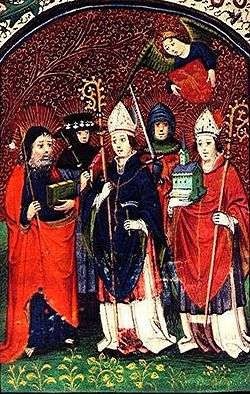


.jpg)


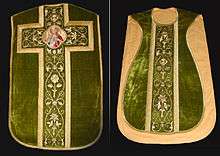


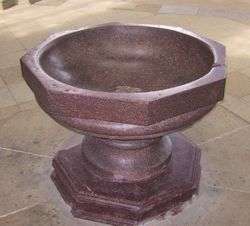
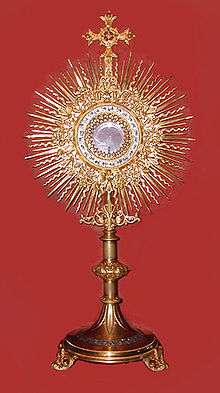
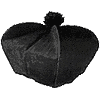

 This article incorporates text from a publication now in the public domain: Herbermann, Charles, ed. (1913). "Symbolism". Catholic Encyclopedia. New York: Robert Appleton.
This article incorporates text from a publication now in the public domain: Herbermann, Charles, ed. (1913). "Symbolism". Catholic Encyclopedia. New York: Robert Appleton.





.jpg)



